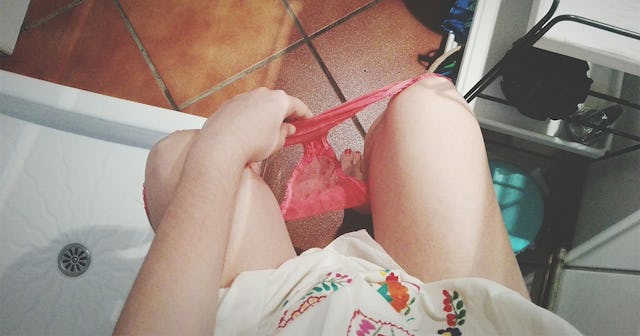Is There Such A Thing As Too Much Vaginal Discharge?

I like to explore things I know little about. I’d call myself an internet-trained doctor who can diagnose maladies ranging from Bipolar II to deep vein thrombosis. The subject of vaginal discharge is one I realized I needed to know more about, since it is something that affects me and my body.
So I set out to learn more. In the inimitable words of SELF Magazine’s Korin Miller, discharge “has way more purpose than just hanging out in your underwear.”
Discharge may seem annoying at best. You have to remember, though, that your vagina is a powerhouse, “an entire ecosystem of good bacteria,” and discharge serves the executive function of keeping it healthy. Discharge’s job is hefty: it helps your vagina stay clean and lubricated, shielding it from infection and irritation. That’s right — your vagina is not just accomplishing that on its own; its sidekick secretion does the heavy lifting.
At times, discharge is a beacon of sorts, signaling that something is not quite right. A white or pale yellow, cottage cheese-y tormentor that causes a wicked itch in your nethers is a pretty good indication of a yeast infection. A heavier, watery, grayish excretion with a pungent, fishy odor suggests bacterial vaginosis. Discharge can turn pus-y or green. It’s hard to ignore this unpleasantness — which is a good thing because you will want to call your doctor and investigate.
What kind of vaginal discharge is a don’t-worry-about-it? Well, there is a very normal range of color and texture throughout your cycle. Discharge might be a stretchy and transparent concoction, like an egg white (which means you are ovulating). It can be clear and watery, especially after exercising. It can be a whitish hue, slightly yellow, or even a bit brown after menstruation. It shouldn’t burn or reek or turn your vulva into a scratching post. In fact, a healthy discharge is probably not too noticeable, except as an intruder in your underpants.
So, thick, thin, sticky, slippery, milky, and/or transparent are all good. One thing you might still wonder about, though: How much vaginal discharge is the right amount?
That is a fair question — without an exact answer.
According to some, most vaginas release approximately one-half to one teaspoon daily. On the other hand, Dr. Maura Quinlan, M.D., M.P.H., an assistant professor in the department of obstetrics and gynecology at the Northwestern University Feinberg School of Medicine, says it’s not that precise. “I tell my patients that discharge is like sweat,” says Quinlan, “Some people don’t sweat very much, and some sweat a lot.” A percentage don’t even have discharge every day.
The menstrual cycle also affects vaginal discharge quantity. Immediately post-period, some vaginas may be a bit parched, but that dryness wanes as the month heads towards ovulation. In the world of discharge, “ovulation discharge” reigns queen, as that is the point when excretions are bountiful. (And, remember, your “bountiful” may be different from your neighbor’s). Then, until your period strikes again, that tell-tale dryness may sneak in again.
Hormonal shifts play a huge part, obviously, so it makes sense that hormonal birth control will play its part as well. Throughout the span of a vagina owner’s reproductive life, estrogen tends to boost vaginal secretions, so an estrogen-packed pill will generally do the same. Even if you’re not approaching your period, that fluid-inducing hormone will do its job. Progesterone is known to thicken and curb secretions, so a pill with progestin (a synthetic progestogen) will do the same. Any way you look at it, a contraceptive that contains estrogen or progesterone alone — or in tandem — would influence the amount of discharge someone might produce, whether bolstering or depleting it.
So, what about pregnancy, which naturally wreaks havoc on your hormones? Jonathan Schaffir, M.D., an ob/gyn at the Ohio State University Wexner Medical Center, explains that pregnancy causes estrogen levels keep rising (to inhibit ovulation), so vaginal discharge is wetter and slicker throughout the gestational period. Schaffir adds that during this time blood volume increases, and that change could increase discharge volume.
All that said, there are times when a noteworthy abundance or dearth of vaginal discharge can indicate something is awry. That is why Schaffir says simply, “You just want to keep tabs on what’s normal for you.”
Anna Druet, former Science and Education Manager and contributor to Clue, has a detailed recipe for this:
“Get to know your cervical fluid….You can use your fingers to feel for fluid at the entryway to your vagina, or at your cervix directly. Look for color and consistency. Feel for things like thickness, wetness, slipperiness (like soap) and stretchiness of the fluid. Another way is to look for fluid on your toilet paper. Cervical fluid should be visible on the paper and look different than your other vaginal moisture. Some people find this is less confusing than collecting fluid with their fingers because touching the vulva/vagina directly can make it harder to decipher cervical fluid from general lubrication. If you want to get into it, you can also try dipping fluid-covered fingers into a glass of water. Cervical fluid will either stay stuck to your fingers or will sink to the bottom of the glass in a little clump. Vaginal moisture, on the other hand, will dissolve in the water.”
In my mind, though, if a suggestion takes over 150 words to explain, you’ve lost me. So, to find my baseline, what’s typical for me, I just pay attention to what my trusty underwear tells me. I like to think of the sage words of Korin Miller: “Feel free to keep tabs on your discharge with a spirit of curiosity, not with a worry that it shouldn’t be there at all.”
This article was originally published on